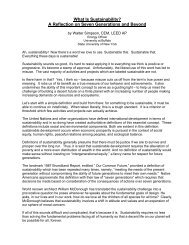Business Guide to Paper Reduction - Tufts Office of Sustainability
Business Guide to Paper Reduction - Tufts Office of Sustainability
Business Guide to Paper Reduction - Tufts Office of Sustainability
You also want an ePaper? Increase the reach of your titles
YUMPU automatically turns print PDFs into web optimized ePapers that Google loves.
on why it is a good idea. Thus, the goal is supported by people at all levels <strong>of</strong> the organization,<br />
which reduces <strong>to</strong>p-down mandates that could be unsupported at the grass-roots level.<br />
Assign the people in the most appropriate positions <strong>to</strong> lead paper reduction efforts.<br />
At the Moore Foundation, the person responsible for leading the paper reduction efforts is the<br />
Chief Technology <strong>Office</strong>r. While in other organizations a different person might be responsible,<br />
the Moore Foundation’s small, centralized organization allows the CTO <strong>to</strong> develop and maintain<br />
the electronic systems that support paper reduction efforts, while remaining in close contact with<br />
the people who will be using the systems once they are set up. Additionally, since Moore is just<br />
being established, they can set up electronic systems <strong>to</strong> minimize paper use without the need <strong>to</strong><br />
overhaul systems that already exist, as is the case with most organizations.<br />
Understand what each process requires before identifying technology <strong>to</strong> invest in.<br />
The initial step in their paper reduction campaign is <strong>to</strong> identify the needs for each process, such<br />
as the grant funding process, internal operations, and other procedures they plan <strong>to</strong> use <strong>to</strong> support<br />
the operations <strong>of</strong> the foundation. Once these are determined, they will then research whether<br />
there is existing technology that can support their operational needs or if they need <strong>to</strong> cus<strong>to</strong>mdesign<br />
s<strong>of</strong>tware.<br />
One example <strong>of</strong> this is establishing their system for s<strong>to</strong>ring information. The grant application<br />
process his<strong>to</strong>rically has been very paper-intensive, potentially requiring extensive filing cabinets<br />
and large floor space. Until they begin accepting grant applications, they will limit funding <strong>to</strong><br />
pilot projects, which will allow them <strong>to</strong> establish the necessary tracking systems. Through this,<br />
they will identify their needs for indexing, s<strong>to</strong>ring, and accessing related documents. This<br />
process will help them determine what their requirements are for an electronic information<br />
s<strong>to</strong>rage system and then buy or develop appropriate s<strong>of</strong>tware. If they bought the s<strong>of</strong>tware before<br />
they knew what they needed, they would likely find challenging limitations. They may hire a<br />
staff librarian <strong>to</strong> manage the information and ensure an appropriate cataloging system. This<br />
system will not only bring them an efficient way <strong>of</strong> accessing their documents, the space savings<br />
is crucial in a city as expensive as San Francisco.<br />
Address the basic internal operations.<br />
Foundations are inherently interactive organizations, with a majority <strong>of</strong> their efforts serving the<br />
needs <strong>of</strong> people outside the organization. As a result, they can expect a continuous flow <strong>of</strong><br />
information <strong>to</strong> and from external entities. With this in mind, the Moore Foundation started by<br />
addressing some <strong>of</strong> the basic <strong>to</strong>ols used <strong>to</strong> communicate. For example, instead <strong>of</strong> using a fax<br />
machine, they installed a fax server. This allows them <strong>to</strong> receive faxes in an email rather than a<br />
printed copy. Additionally, they can send faxes directly from their computers without needing <strong>to</strong><br />
print them first. This saves the need for an initial printing, gives people the option not <strong>to</strong> print,<br />
and takes less time than traditional printing and faxing.<br />
As a foundation, they will be publishing numerous reports, some <strong>of</strong> which may be lengthy.<br />
Studies indicate that this may be one <strong>of</strong> the more challenging areas <strong>of</strong> paper reduction. 87 To<br />
address this, they began with a commitment <strong>to</strong> providing the best computer screen for the job –<br />
digital flat panel computer screens. These screens facilitate reading because they allow text <strong>to</strong> be<br />
<strong>Business</strong> <strong>Guide</strong> <strong>to</strong> <strong>Paper</strong> <strong>Reduction</strong> 34







